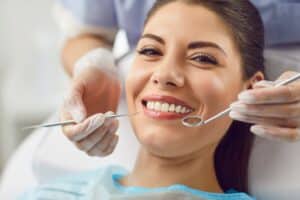Tired of not feeling like you can smile because your teeth are stained yellow or tinted a dull gray? We have 9 tips to help bring the luster back to your smile, ranging from eating teeth-whitening foods to avoiding beverages that discolor your smile.
- Go on a pearly white diet
If you like to drink beverages like black tea or red wine, expect the results to impact your smile. Colas, gravies, and dark juices also will affect your pearly whites and so will cigars and cigarettes. Remember, if it’s dark before you consume it, then it will stain your teeth. Brush right away after eating or drinking foods that can stain your teeth.
- Eat foods that scrub
Firm or crisp foods help clean your teeth as they are eaten. Among the best are apples, which are known as nature’s toothbrush. Other good choices include raw carrots and celery, plus popcorn. For best results, make ‘scrubbing’ foods the final food you eat in your meal if you aren’t going to brush right after your meal. In addition, look for foods that trigger a lot of saliva, which is your mouth’s way of washing away food debris. These foods include apples, pears, celery and carrots. In addition, if you chew sugarless gum after you eat, you will get a tooth-cleansing action and it will also trigger saliva production. The saliva also neutralizes the acid that creates tooth decay.
- Use nature’s mouthwash – apple cider vinegar
Apple cider vinegar helps remove stains, whiten teeth, and kill bacteria in your mouth and gums. Swish it around your mouth before you brush in the morning.
- Include baking soda and/or salt when you brush your teeth
Baking soda will remove stains and whiten your teeth. Brush with it once a week use it just like toothpaste. As an alternative to brushing with toothpaste daily, you can use salt. If you find your gums are starting to feel raw, switch to brushing with salt every other day.
- Replace your toothbrush
Replace your manual toothbrush every three months and the same goes for your electric toothbrush. If you keep using the same toothbrush, you’re just putting bacteria back in your mouth daily. The best way to brush is by placing your toothbrush at a 45-degree angle against your gums and gently moving it in a circular motion, rather than a back-and-forth motion.
- Learn to floss anytime and anywhere
Flossing doesn’t have to be something you do at home in front of the mirror in your bathroom. If you can learn to floss without a mirror, it means you can floss anywhere your car (not while you’re driving, though), at the office, in a park, or in bed (by yourself!). Be sure to buy multiple containers of floss and keep them in your vehicle, your desk , in your nightstand, or in your purse or briefcase.
- Brush at strategic times
When you first get up and just before you go to bed are the two best times to brush your teeth. Why? Because saliva dries up when you sleep, it’s smart to get all of the plaque off your teeth before bed time. Remember, plaque causes cavities. In the morning, brush right away to remove plaque and bacteria from your teeth.
- Give whitening toothpastes and rinses a try
Some stains on your teeth can be removed with whitening toothpastes, gels, and rinses. They often contain abrasives, chemicals, or polishing agents to help whiten your teeth. And unlike bleaches, they don’t change the natural color of teeth.
- Try tooth whitening bleaches but be careful
If you decide to use a tooth whitening bleach, be careful. Bleach won’t lighten dental veneers, bonding, fillings, crowns, and bridges. This means that they will look odd next to your natural teeth that you just had whitened. If you take care with foods and drinks that discolor teeth, the results of whitening may last up to one year. Whitening teeth too often could make them look translucent and blue, so you’ll want to maintain your new smile.
Source: WebMD, Readers Digest (Stealth Health)



